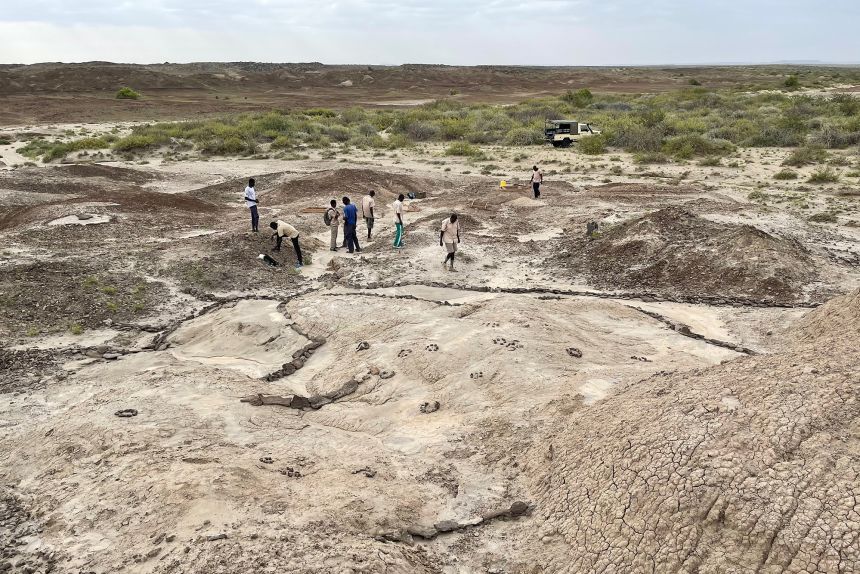The first known hand fossils of an extinct human relative have been discovered in Kenya, revealing a species with unexpected dexterity and a gorilla-like grip. The hand bones, which were discovered alongside fossil skulls and teeth, lead researchers to believe these early humans may have used stone tools.
Paranthropus boisei was previously identified only by its distinctive skull and large teeth, with molars up to four times larger than those of living humans. So researchers didn’t know what the rest of the body looked like or how the hominid interacted with its environment. However, they have theorized about the enormous chewing muscles his jaw contained and his eating habits, earning him the nickname Nutcracker Man.
The remarkably well-preserved hand bones include a long thumb, straight fingers, and a movable little finger that would have allowed the species to form a powerful grip, similar to the way modern humans might grip a hammer. Other features, such as the broad shape of the finger bones, however, are very gorilla-like.
The partial skeleton, excavated at Koobi Fora, a site east of Lake Turkana, is estimated to be just over 1.52 million years old. The teeth and skull fossils matched previously studied P. boisei specimens, while the hand and foot bones were found to be unique among previously studied hominids, a term referring to all species that emerged after the genetic split of great ape ancestors 6 to 7 million years ago.
“This is the first time we can confidently link Paranthropus boisei to specific hand and foot bones,” said Carrie Mongle, a paleoanthropologist and assistant professor at Stony Brook University in New York. Mongle is the lead author of a study of the fossils published Wednesday in the journal Nature.
The hand was “quite unexpected,” according to Tracy Kivell, director of the department of human origins at the Max Planck Institute for Evolutionary Anthropology in Leipzig, Germany.
“This is clearly the hand of a human ancestor, but it also has remarkably similar features to gorillas, which is surprising,” Kivell said by email.
“No other hominin that we know of has such a gorilla-like hand morphology, which greatly broadens our perspective on what is ‘possible’ in (the) human evolutionary history of hand use,” she added. Kivell co-authored a commentary published alongside the study, but was not involved in the research.
P. boisei lived in East Africa 1.3 million to 2.6 million years ago, coexisting with at least three other hominid species: Homo habilis, Homo rudolfensis and Homo erectus.
Some researchers have hypothesized that only species in the genus Homo had the ability to make stone tools, although recent discoveries have called this hypothesis into question. Stone artifacts discovered in Kenya dating back 2.9 million years suggest that tool use was more widespread across the hominid family tree than once thought.
Hominids include species of the genus Homo, such as our own Homo sapiens; more recently extinct species such as the Neanderthals, who disappeared 40,000 years ago; the first species of Homo such as Homo erectus; and more distant species like Australopithecus afarensis, represented by the famous Lucy skeleton in Ethiopia, 3.2 million years old.
Mongle said the proportions of P. boisei’s hands would have allowed it to manipulate stone tools as well as other Homo species living in Africa at the time. “This paper is careful not to claim that Paranthropus made and used tools, but rather asserts that there is essentially nothing in the anatomy of the hand that would prevent this,” Ryan McRae, a paleoanthropologist at the Smithsonian National Museum of Natural History in Washington, DC, said in an email to CNN.
“Without a smoking gun of stone tools found in a fossilized hand, or stone tools found at a site with only one (one) hominid species represented, we may never know for sure who did and did not make these tools, but this paper is a big step toward the ‘Paranthropus the toolmaker’ hypothesis.”
Later humans, such as Neanderthals and Homo sapiens, had different wrist anatomy, and P. boisei, as well as its contemporaries, would likely not have been able to precisely pinch its fingers, the study notes.
The hand fossils also suggest that P. boisei shared grasping abilities with gorillas, which would have allowed it to grasp and strip hard-to-eat plants, removing indigestible parts with its hands, according to the study.
While its powerful hands indicate that it would have been an adept climber, the hominin’s feet had arches, which allowed for efficient movement.
That means it was definitely adapted to walking upright on two legs, Mongle said.
“Because of the combined hand and foot morphology, the authors suggest that this species was probably not arboreal (tree climbing), but that any convergence with gorillas in the hand is likely due to the way they used their hands to process hard foods. This makes sense,” added McRae, who was not involved in the study.

The fossils were discovered during excavations between 2019 and 2021 by a team led by co-author Louise Leakey. In the 1950s, his grandparents, renowned paleoanthropologists Louis Leakey and Mary Leakey, discovered the first P. boisei skull in what is now Tanzania and gave him the nickname Nutcracker Man. However, wear marks on the species’ teeth indicate that instead of cracking hard foods like nuts, it chewed and ground hard foods like tubers and roots to survive.
The latest fossils emerged from a layer of sandy silt just above an extraordinary hominid footprint made public last year.
Embedded in the soft mud, the footprints were attributed to P. boisei and Homo erectus, leading researchers to believe that the two species interbred and were capable of living as neighbors, not competitors, in the same habitat.
Mongle said the two species would have occupied different ecological niches, but based on what is known about the hominin’s face, teeth, jaws and now hands, P. boisei likely had a specialized diet of plant foods such as grasses.
Sign up for CNN’s Wonder Theory science newsletter. Explore the universe with information on fascinating discoveries, scientific advances and much more.









